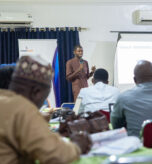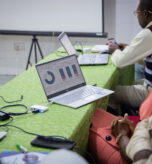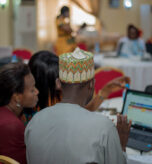
What is Climate Finance?
The United Nations Framework Convention on Climate Change (UNFCCC) defined it as “local, national, or transnational financing—drawn from public, private, and alternative sources of financing—that seeks to support mitigation and adaptation actions that will address climate change” (Harrison, G. Andrew and Jose 2020). As we move toward an environmentally sustainable economy, climate finance aims to reduce climate risk by encouraging the flow of investment capital toward green projects and away from brown industries and businesses.
Although climate finance has become a central element of climate discussions since 1992, it was not until 2010 that it became a mainstream topic, and the Green Climate Fund (GCF) was established. The Green Climate Fund is a key delivery mechanism for the $100 billion-a-year financial commitment from developed countries to developing countries to tackle the disproportionate burdens of climate change they experience.

It’s an uphill battle…
On June 1, 2017, Donald Trump, former President of the US, announced the US’ intention to withdraw from the Paris Agreement, the global accord that implements the objectives of the UNFCCC. The withdrawal came with cessation of implementation of the Paris Agreement including the Nationally Determined Contribution and contributions to the Green Climate Fund. The cessation and most importantly the withdrawal of funding for the GCF by the US presented three challenges (Megan and Minas 2018);
- Sufficient capitalization of the fund
- Workable governance of the fund at the board level
- Oversight and guidance of the Fund by the UNFCCC COP
Another challenge is the measurement of the financial value, which does not consider the differing costs for climate change solutions in different regions or countries. The African continent, for example, contributes the least to climate change, yet it is the most vulnerable to its impacts, meanwhile, the G20 nations contribute around 75% of global greenhouse emissions and are least affected by the immediate impacts of climate change. African countries that contribute so little will have to spend up to five times more on adapting to the climate crisis than on healthcare.
There remain massive financial requirements projected for mitigating and adapting to climate change effects, which far exceed the current commitments. The Green Climate Fund, for example, while being the largest climate fund globally with $30 billion raised, covers only a fraction of the hundreds of billions needed annually.
The financing landscape is further complicated by the reality that most public climate finance currently takes the form of debt with exorbitantly high-interest rates for most of the world. Usually resulting in countries finding themselves caught in a cycle of increasing indebtedness, borrowing to finance repairs or recovery of climate change-related disasters.

Efforts so far…
In order to limit the earth’s temperature increase to 1.5°C above pre-industrial levels and eventually achieve net-zero emissions (by 2050), genuine climate actions require an annual investment of $4 trillion in renewable energy – far lower than the $7 trillion spent on fossil fuel subsidies.
At the World Climate Action Summit, which kickstarted the COP 28 conference in Dubai, Parties reached an agreement on the operationalization of the loss and damage fund and funding arrangements. This historic moment was followed by a financial commitment to the tune of $700 million by numerous member nations. The fund will be used to support countries that are most affected and at risk of adverse events from climate change.
UAE also committed $30 billion in a new climate investment venture, named Alterra. Alterra aims to mobilize $250 billion in investment by the end of the decade. A (meager) five billion dollars out of this “private investment vehicle for climate change action” will be allocated to poorer countries, as stated by Sultan Ahmed Al-Jaber, President of the COP 28 summit.
Just Energy Transition Partnerships (JETP), a G7-led partnership that uses concessionary finance to help emerging economies transition from excess reliance on coal to a greener energy mix. At COP 26, an $8.5 billion plan for South Africa’s transition was announced, making it the first JETP fund. Another set of plans was launched in 2022 for Indonesia and Vietnam at about $20 billion and $15.5 billion, respectively.

Africa at COP 28
Africa Day was celebrated on the 2nd of December 2023, at the COP 28 summit, under the theme “Scaling up Financing for Climate Action and Green Growth in Africa.”
The Africa Day event provided a platform to make a compelling argument for using investment capital to accelerate the transition to climate-compatible growth for sustainable development while also promoting business and ecosystems., and an opportunity to amplify Africa’s voice at the COPs, highlight Africa’s challenges, opportunities and responses to Climate Change.
In attendance were, Dr Akinwumi Adesina, The President of the African Development Bank; Mr Moussa Faki Mahamat, President of the African Union Commission, Mr Claver Gatete, Executive Secretary of the United Nations Economic Commission for Africa, and other dignitaries who all contributed to discourse on climate actions and its financing in Africa.

Conclusion
Climate finance stands at a critical juncture, teetering between commendable strides and pressing challenges. The Green Climate Fund, Just Energy Transition Partnerships, and other funds signal a growing global commitment to addressing climate change, however, challenges persist.
As we strive for a climate-resilient future, Africa’s plea for fairness echoes globally, emphasizing that climate finance must not only be substantial but also justly distributed, considering the disparate impacts and contributions of nations. The journey toward a sustainable future demands not just a financial commitment but a holistic and inclusive approach.
References
Harrison, Hong, Karolyi G. Andrew, and A. Scheinkman Jose. 2020. “Climate Finance.” The Review of Financial Studies 1.
IOM. 2023. News – Global. October 07. https://www.iom.int/news/storm-daniel-urgent-funding-scale-needed-four-weeks-after-libya-disaster#:~:text=Storm%20Daniel%20caused%20catastrophic%20flooding,and%20approximately%208%2C540%20others%20missing.
Megan, Bowman, and Stephen Minas. 2018. “Resilience Through Interlinkage: The Green Climate Fund and Climate Finance Governance.” Climate Policy 2.
Rafferty, John P. 2023. Libya Flooding of 2023. September 27. https://www.britannica.com/topic/I-Have-A-Dream.




